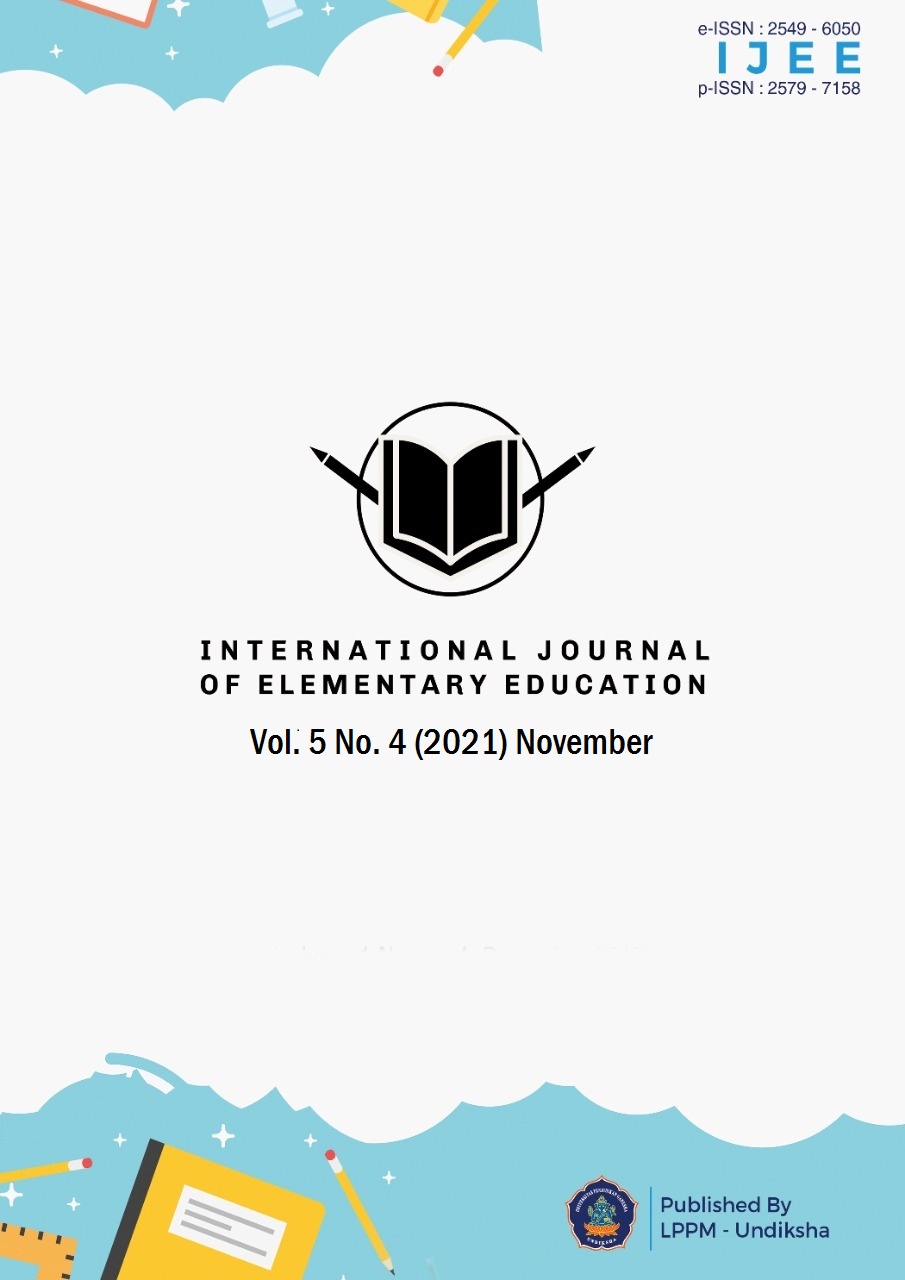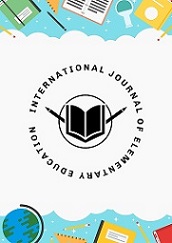Mobile Game for Equality of Fractions for Elementary School Students
DOI:
https://doi.org/10.23887/ijee.v5i4.41076Keywords:
Equalityof Fraction, Learning Outcomes, Mobile TechnologyAbstract
The low learning outcomes in the equality of fractions material are due to the unavailability of mobile technology game media that can train and explore the pattern of equality of fractions appropriately. This study aims to produce a valid, practical, and effective mobile game for equality of fractions (MoGEF) to improve learning outcomes on equality of fractions material. This study uses research and development methods through analysis, design, development, implementation, and evaluation. The subjects of this study were 29 students in the fourth grade of elementary school. Validity was measured by assessing two experts (mathematical education expert and information technology education expert). Practicality was measured through the results of the student response questionnaire, while effectiveness was measured through the posttest of student learning outcomes after using MoGEF. Data were collected using questionnaires and tests. The validity results obtained an average of 86.06% in the interval of 85.00% 100.00% with completely valid criteria. Practicality obtained an average of 4.659, which is in the interval of 2.50 3.25 with very practical criteria. Effectivenes shows the criteria of 79.83% berada pada interval 70.00% 85.00% dengan kriteria efektif. The effectiveness of the mobile game obtained a significance value of 2.127 > 2.048, which means it can improve the learning outcomes of elementary school students in the equality of fractions material. Therefore, the development of mobile games for equality of fraction is concluded to be very valid, very practical, and effective.
References
Akbar, S. (2017). Instrumen perangkat pembelajaran. Bandung : PT Remaja Rosdakarya.
Amir, M. F., & Wardana, M. D. K. (2018). Pengembangan domino pecahan berbasis open ended untuk meningkatkan kemampuan berpikir kreatif siswa sd. AKSIOMA: Jurnal Program Studi Pendidikan Matematika, 6(2), 178. https://doi.org/10.24127/ajpm.v6i2.1015.
Ardina, F. N., Fajriyah, K., & Budiman, M. A. (2019). Keefektifan model realistic mathematic education berbantu media manipulatif terhadap hasil belajar matematika pada materi operasi pecahan. Jurnal Pedagogi Dan Pembelajaran, 2(2), 151. https://doi.org/10.23887/jp2.v2i2.17902.
Arsyad, M. N., & Lestari, D. E. G. (2020). Efektifitas penggunaan media mobile learning berbasis android terhadap hasil belajar mahasiswa ikip budi utomo malang. Agastya: Jurnal Sejarah Dan Pembelajarannya, 10(1), 89. https://doi.org/10.25273/ajsp.v10i1.5072.
Astra, I. M., Nasbey, H., & Nugraha, A. (2015). Development of an android application in the form of a simulation lab as learning media for senior high school students. Eurasia Journal of Mathematics, Science and Technology Education, 11(5), 1081–1088. https://doi.org/10.12973/eurasia.2015.1376a.
Attard, C., & Holmes, K. (2020). "It gives you that sense of hope": An exploration of technology use to mediate student engagement with mathematics. Heliyon, 6(1), e02945. https://doi.org/10.1016/j.heliyon.2019.e02945.
Azizah, A. N, Fitrianawati, M. (2020). Pengembangan media ludo math pada materi pecahan sederhana bagi peserta didik kelas iii sekolah dasar. https://doi.org/10.24176/wasis.v1i1.4709.
Baiquni, I. (2016). Penggunaan media ular tangga terhadap hasil belajar matematika. Jkpm, 01(02), 193–203. https://doi.org/10.30998/jkpm.v1i2.1187.
Chun, R. (2017). Adobe animate CC. Amerika : Peachit
de Ribaupierre, A. (2015). Piaget’s Theory of Cognitive Development. International Encyclopedia of the Social & Behavioral Sciences: Second Edition, 18, 120–124. https://doi.org/10.1016/B978-0-08-097086-8.23093-6.
Dorris, C., Winter, K., O’Hare, L., & Lwoga, E. T. (2021). Protokol: A systematic review of mobile device use in the primary school classroom and its impact on pupil literacy and numeracy attainment. Campbell Systematic Reviews, 17(2). https://doi.org/10.1002/cl2.1155.
Efriyanti, L., Annas, F. (2020). Aplikasi mobile learning sebagai sarana pembelajaranabad 21 pada era revolusi industri 4.0. 5(1). https://doi.org/10.30983/educative.v5i1.3132.
Fasha, A., Johar, R., & Ikhsan, M. (2018). Peningkatan kemampuan pemecahan masalah dan berpikir kritis matematis siswa melalui pendekatan metakognitif. Jurnal Didaktik Matematika, 5(2), 53–64. https://doi.org/10.24815/jdm.v5i2.11995.
Fatoni, P., Rosalina, M. (2021). Efektifitas penggunaan games edukasi untuk meningkatkan kemampuan dan hasil belajar siswa dengan aplikasi mobile learning pada mata kuliah computer programming. 13(1), 80–96. https://doi.org/10.37424/informasi.v13i1.74.
Flores-Velazquez, S., Jaimez-González, C. R., & García-Mendoza, B. (2021). Mobile application to practice fractions through games for primary school children. Universal Journal of Educational Research, 9(1), 76–84. https://doi.org/10.13189/ujer.2021.090109.
Geller, E. H., Son, J. Y., & Stigler, J. W. (2017). Conceptual explanations and understanding fraction comparisons. Learning and Instruction, 52, 122–129. https://doi.org/10.1016/j.learninstruc.2017.05.006.
Hakim, A. R., & Windayana, H. (2016). Pengaruh penggunaan multimedia interaktif dalam pembelajaran matematika untuk meningkatkan hasil belajar siswa sd. EduHumaniora | Jurnal Pendidikan Dasar Kampus Cibiru, 4(2). https://doi.org/10.17509/eh.v4i2.2827.
Hidayat, W., Patmanthara, S., Setiani, A., Sutikno, T. A., & Sutadji, E. (2020). Pelatihan pengembangan mobile game edukasi untuk guru smk bidang teknologi komputer dan informatika kota malang. Jurnal Karinov, 3(1). https://doi.org/10.17977/um045v3i1p31-36.
Indriani, A. (2018). Penggunaan blok pecahan pada materi pecahan sekolah dasar. JIPMat, 3(1), 11–16. https://doi.org/10.26877/jipmat.v3i1.2418.
Ivonne, H. P. A., Alberto, M. P. M., & Guadalupe, C. F. R. (2020). Augmented reality application for teaching basic operations with fractions of the same denominator. Journal of Computer Science, 16(7), 1042–1062. https://doi.org/10.3844/jcssp.2020.1042.1062.
Jordan, N. C., Hansen, N., Fuchs, L. S., Siegler, R. S., Gersten, R., & Micklos, D. (2013). Journal of experimental child developmental predictors of fraction concepts and procedures. Journal of Experimental Child Psychology, 116(1), 45–58. https://doi.org/10.1016/j.jecp.2013.02.001.
Kaskens, J., Segers, E., Goei, S. L., van Luit, J. E. H., & Verhoeven, L. (2020). Impact of Children's math self-concept, math self-efficacy, math anxiety, and teacher competencies on math development. Teaching and Teacher Education, 94, 103096. https://doi.org/10.1016/j.tate.2020.103096.
Maharbid, D. A., Gumala, Y., Jupri, A., Herman, T. (2018). Mobile game design for understanding fractional conception in elementary school. International, 3, 836–841. http://science.conference.upi.edu/proceeding/index.php/ICMScE/article/view/61.
Molenda, M. (2007). In search of the elusive addie model. Performance Improvement, 46(9), 9–16. https://doi.org/10.1002/pfi.
Noorhidawati, A., Ghalebandi, S. G., & Siti Hajar, R. (2015). How do young children engage with mobile apps? Cognitive, psychomotor, and affective perspective. Computers and Education, 87, 385–395. https://doi.org/10.1016/j.compedu.2015.07.005.
Nuryani, Astuti, T. D., Utami. E. S., Budiantoro, M. (2017). Dasar - dasar statistik penelitian. Yogyakarta : Sibuku Media
Parnabhhakti, L., & Ulfa, M. (2020). Perkembangan matematika dalam filsafat. 1(1), 11–14. https://doi.org/10.33365/ji-mr.v1i1.154.
Parsazadeh, N., Ali, R., & Rezaei, M. (2018). A framework for cooperative and interactive mobile learning to improve online information evaluation skills. Computers and Education, 120(May 2017), 75–89. https://doi.org/10.1016/j.compedu.2018.01.010.
Pujiati, P., Kanzunnudin, M., & Wanabuliandari, S. (2018). Analisis pemahaman konsep matematis siswa kelas IV sdn 3 gemulung pada materi pecahan. ANARGYA: Jurnal Ilmiah Pendidikan Matematika, 1(1), 37–41. https://doi.org/10.24176/anargya.v1i1.2278.
Purpura, D. J., & Schmitt, S. A. (2019). Cross-domain development of early academic and cognitive skills. Early Childhood Research Quarterly, 46, 1–4. https://doi.org/10.1016/j.ecresq.2018.10.009.
Rahaju, R., & Hartono, S. R. (2017). Pembelajaran operasi pecahan dengan kartu domino pintar. JIPMat, 1(2), 173–181. https://doi.org/10.26877/jipmat.v1i2.1244.
Rahmat, R. F., Mursyida, L., Rizal, F., Krismadinata, K., & Yunus, Y. (2019). Pengembangan media pembelajaran berbasis mobile learning pada mata pelajaran simulasi digital. Jurnal Inovasi Teknologi Pendidikan, 6(2), 116–126. https://doi.org/10.21831/jitp.v6i2.27414.
Rasvani, N. L. A., & Wulandari, I. G. A. (2021). Pengembangan media pembelajaran aplikasi maca ( materi pecahan ) berorientasi teori belajar ausubel muatan matematika. Mimbar PGSD Undiksha, 9(1), 74–81. https://doi.org/10.23887/jjpgsd.v9i1.32032.
Sao, S., Mei, A., Ningsih, N., Mei, M. F., Wondo, M. T. S., Seto, S. B., Naja, F. Y., Meke, K. D. P., & Manda, G. S. (2021). Bimbingan belajar di rumah menggunakan alat peraga blok pecahan pada masa pandemi covid 19. Mitra Mahajana: Jurnal Pengabdian Masyarakat, 2(2), 193–201. https://doi.org/10.37478/mahajana.v2i2.1031.
Setiawan, Y. U., Asih, I., Yandari, V., & Pamungkas, A. A. N. S. (2020). Development of fraction domino card as mathematics learning media in elementary school class IV. 12(01), 1–12. https://doi.org/10.30998/formatif.v11i1.8158.
Siegler, R. S., & Pyke, A. A. (2013). Developmental and individual differences in understanding of fractions. Developmental Psychology, 49(10), 1994–2004. https://doi.org/10.1037/a0031200.
Simsek, I., & Can, T. (2020). Using tablets for technology integration in classroom differentiation. The Role of Technology in Education, 1–20. https://doi.org/10.5772/intechopen.85713.
Suartama, I. K., Setyosari, P., Sulthoni, & Ulfa, S. (2019). Development of an instructional design model for mobile blended learning in higher education. International Journal of Emerging Technologies in Learning, 14(16), 4–22. https://doi.org/10.3991/ijet.v14i16.10633.
Sugiyono. (2017). Metode penelitian pendidikan pendekatan kuantitatif, kualitatif, dan R & D. Bandung : Alfabeta.
Tetzlaff, D. M. (2017). Using mobile technology to increase the math achievement and engagement of students with disabilities. Dissertation Abstracts International Section A: Humanities and Social Sciences, 3-A(E), No-Specified. https://doi.org/10.34917/11156827.
Tonra, W. S. (2016). Pembelajaran number sense untuk meningkatkan hasil belajar siswa sekolah dasar pada materi pecahan. 109–116. https://doi.org/10.33387/dpi.v5i2.233.
Wahyuningtyas, S., & Leonard, L. (2021). Developing Matmino (domino mathematics) learning media in grade 7 algebra material. Formatif: Jurnal Ilmiah, 11(148), 1–14. https://doi.org/10.30998/formatif.v11i1.8158.
Yasa, A. D. (2020). Pengembangan e-evaluation berbasis aplikasi hot potatoes untuk siswa kelas V sekolah dasar. Jurnal Ilmiah Sekolah Dasar, 4(1), 26. https://doi.org/10.23887/jisd.v4i1.23987.
Zhang, D., & Rivera, F. D. (2021). Predetermined accommodations with a standardized testing protocol: Examining two accommodation supports for developing fraction thinking in students with mathematical difficulties. Journal of Mathematical Behavior, 62(January), 100861. https://doi.org/10.1016/j.jmathb.2021.100861.
Downloads
Published
How to Cite
Issue
Section
License
Authors who publish with the International Journal of Elementary Education agree to the following terms:
- Authors retain copyright and grant the journal the right of first publication with the work simultaneously licensed under a Creative Commons Attribution License (CC BY-SA 4.0) that allows others to share the work with an acknowledgment of the work's authorship and initial publication in this journal.
- Authors are able to enter into separate, additional contractual arrangements for the non-exclusive distribution of the journal's published version of the work (e.g., post it to an institutional repository or publish it in a book), with an acknowledgment of its initial publication in this journal.
- Authors are permitted and encouraged to post their work online (e.g., in institutional repositories or on their website) prior to and during the submission process, as it can lead to productive exchanges, as well as earlier and greater citation of published work. (See The Effect of Open Access)










